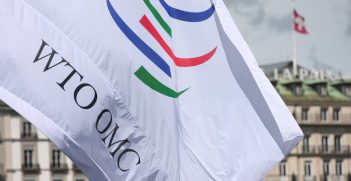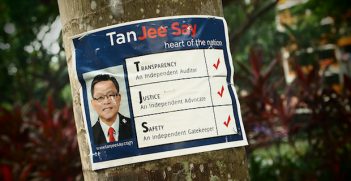Pacific Islands Forum: Climate ‘Consensus’ on the Road to Paris

The Leaders’ Declaration on Climate Change Action, which emerged from the Pacific Islands Forum in Port Moresby on 10 September, doesn’t provide the basis for a cohesive diplomatic strategy for Pacific Island states as they move toward the crucial UN Climate Change conference in Paris this November.
Far from presenting a clear position, the Declaration is rather an exercise in creative ambiguity aimed at papering over the fundamental differences between Australia and New Zealand on the one hand, and the Pacific Island states on the other.
This creative ambiguity allows very different claims to be made about the Declaration. The Secretary-General of the Forum Secretariat, Dame Meg Taylor, has argued that it represents a Pacific consensus, and even a position of ‘solidarity’. This assessment doesn’t sit well with Kiribati President Anote Tong’s reported view at the post-Forum press conference that the leaders had ‘agreed to disagree’ or New Zealand Prime Minister Key’s comments that ‘we’re all going to Paris; we’re all going to argue different things’.
Creative ambiguity is most in evidence on the key question of the warming threshold to be tabled as the Pacific position at the global treaty negotiations in Paris. The declared position of Pacific Island states is that global warming has to be kept under 1.5 degrees to avoid the severe impacts of sea-level rise and extreme weather events on vulnerable states.
On the surface, the Declaration’s acknowledgement ‘that an increase of 1.5 degrees Celsius would severely exacerbate the particular challenges facing the most vulnerable smaller island states of the Pacific’ looks like a commitment to press for global warming of less than 1.5 degrees, and therefore a ‘win’ for the Pacific Island states. The Forum Secretary-General, for example, argues that the Declaration ‘captures’ the Pacific leaders’ concern to support a 1.5 degree threshold.
However, this isn’t the case. While there’s acknowledgement that warming of more than 1.5 degrees would have serious implications for smaller island states, the opaque language of the subsequent clause urges that ‘all effort be made to stay within the global temperature goal, as noted by the Conference of Parties to the UNFCCC in its decision of 1/CP20’ (the 2014 UN Climate Change Conference in Lima). This ‘global temperature goal’ is actually ‘1.5 or 2’; it therefore encompasses Australia and New Zealand’s commitment to a 2 degree threshold.
The ambiguity contained in this commitment has allowed several different interpretations of the Declaration’s commitment on this crucial mitigation issue. Some commentators have interpreted the Declaration as endorsing 2 degrees, presumably based on Prime Minister Abbott’s misrepresentation of the agreed global temperature goal at Lima as 2 degrees and on the knowledge that Australia and New Zealand would only sign on to 2 degrees; others have seen it as endorsing 1.5 degrees only, presumably because the simultaneous commitment to 2 degrees is hidden by the opaque textual reference to ‘decision 1/CP20’. The leaders, however, were well aware that they had signed on to a declaration, which supported 1.5 or 2, or in President Tong’s words, ‘a range of numbers’. New Zealand’s Prime Minister Key is reported as admitting that ‘the Leaders did not agree to a single and unified position’.
At the end of the day, this represents an Australian and New Zealand veto of the effort of Pacific Island states to have the Pacific Islands Forum endorse a strong climate statement for Paris.
It’s not just that Australia and New Zealand weren’t willing to shift their own emissions policies to support the Pacific Island states’ position; it’s that they have denied the Pacific Island leaders the opportunity to make an unambiguous call for a warming target of less than 1.5 degrees through the pre-eminent regional political body.
The Forum Declaration therefore doesn’t provide the basis for a solid strategy going forward to Paris. Because it holds the Pacific’s High Level Political Declaration hostage to Australian and New Zealand interests, it in fact means the Pacific Island states have been forced to bargain away an unambiguous 1.5 degree position at the regional level even before they enter the global coalition-building phase in the lead-up to the Paris conference.
Far from an early negotiation—with two OECD states being an advantage—(as argued by the Secretary-General) this decision dilutes the Pacific Island states’ positions before it leaves its home region. The Port Moresby Agreement missed the opportunity to make a clear statement on the 1.5 degree strategic objective as a basis for building coalitions with like-minded states such as the 54 African states (which have already made a clear commitment to the 1.5 threshold in the March 2015 Cairo Declaration) and the 30 fellow members of the Alliance of Small Islands States (which made a clear call for a 1.5 threshold in Bonn in August).
The absence of a clear, shared objective in the Forum Declaration doesn’t lay the foundation for a clear strategy to prepare for Paris—it’s created a repeat of the circumstances in the lead-up to the UN Climate Change Conference in Copenhagen in 2009.
At the Cairns Forum, on the eve of Copenhagen, the Pacific Islands states’ strong position was watered down to suit the interests of Australia and New Zealand, and the Pacific Island states had no choice but to work outside the Pacific Islands Forum to pursue their position.
The task of developing and prosecuting the Pacific position in the lead-up to Paris will therefore more likely fall to the alternate diplomatic system, which has grown up outside the Pacific Islands Forum since 2009, precisely to deal with this problem.
This new diplomatic system includes the Pacific Small Island Developing States (PSIDS) group at the United Nations which has all but replaced the Pacific Islands Forum group as the most effective representative of Pacific Island interests on key global issues including climate change. Unlike the Forum, PSIDS allows the group of Pacific Island state ambassadors to work collectively without Australian and New Zealand.
There’s also the Pacific Islands Development Forum (PIDF), established by Fiji three years ago. The PIDF has recently found its strength on the climate change issue. At its September 2015 PIDF meeting, which focused on climate change, leaders worked effectively on determining shared strategic objectives and agreed on the outline of key steps for pursuing them on the road to Paris. The resulting Suva Declaration on Climate Change captured the shared interests of most Pacific Island states and civil society, and will be championed by the Fiji Government in the lead-up to Paris.
For the 20 years since the Kyoto Conference, the Pacific Island states have had the development and implementation of their joint climate strategy frustrated by the totally divergent interests of Australia and New Zealand.
The commitment to a unanimous consensus in Forum declarations has effectively worked as a veto power for the two larger neighbours. Forum consensus has therefore come at the cost of sacrificing the core diplomatic objectives of the Pacific Island states, which in turn has constrained effective strategic implementation.
Associate Professor Greg Fry is academic coordinator in Graduate Studies in Diplomacy and International Affairs at The University of the South Pacific. This article was originally published in The Strategist on 21 September 2015. It is republished with permission.





